Future Scenarios for Viticultural Suitability under Conditions of Global Climate Change in Extremadura, Southwestern Spain
Abstract
:1. Introduction
2. Materials and Methods
2.1. Study Area
2.2. Climate Data and Future Scenarios
2.3. Bioclimatic Indices
2.4. Statistical Analysis
3. Results and Discussion
4. Conclusions
Author Contributions
Funding
Institutional Review Board Statement
Data Availability Statement
Conflicts of Interest
References
- Ceglar, A.; Toreti, A.; Lecerf, R.; van der Velde, M.; Dentener, F. Impact of meteorological drivers on regional inter-annual crop yield variability in France. Agric. For. Meteorol. 2016, 216, 58–67. [Google Scholar] [CrossRef]
- Hannah, L.; Roehrdanz, P.R.; Ikegami, M.; Shepard, A.V.; Shaw, M.R.; Tabor, G.; Zhi, L.; Marquet, P.A.; Hijmans, R.J. Climate change, wine, and conservation. Proc. Natl. Acad. Sci. USA 2013, 110, 6907–6912. [Google Scholar] [CrossRef] [PubMed] [Green Version]
- Ashenfelter, O.; Storchmann, K. Climate Change and Wine: A Review of the Economic Implications. J. Wine Econ. 2016, 11, 105–138. [Google Scholar] [CrossRef]
- Drappier, J.; Thibon, C.; Rabot, A.; Geny-Denis, L. Relationship between wine composition and temperature: Impact on Bordeaux wine typicity in the context of global warming—Review. Crit. Rev. Food Sci. Nutr. 2019, 59, 14–30. [Google Scholar] [CrossRef]
- Jones, G.V.; Webb, L.B. Climate Change, Viticulture, and Wine: Challenges and Opportunities. J. Wine Res. 2010, 21, 103–106. [Google Scholar] [CrossRef]
- Kizildeniz, T.; Mekni, I.; Santesteban, H.; Pascual, I.; Morales, F.; Irigoyen, J.J. Effects of climate change including elevated CO2 concentration, temperature and water deficit on growth, water status, and yield quality of grapevine (Vitis vinifera L.) cultivars. Agric. Water Manag. 2015, 159, 155–164. [Google Scholar] [CrossRef] [Green Version]
- Martínez-Lüscher, J.; Kizildeniz, T.; Vucetic, V.; Dai, Z.; Luedeling, E.; van Leeuwen, C.; Gomès, E.; Pascual, I.; Irigoyen, J.J.; Morales, F.; et al. Sensitivity of grapevine phenology to water availability, temperature and CO2 concentration. Front. Environ. Sci. 2016, 4, 48. [Google Scholar] [CrossRef] [Green Version]
- Tomás, M.; Medrano, H.; Escalona, J.M.; Martorell, S.; Pou, A.; Ribas-Carbó, M.; Flexas, J. Variability of water use efficiency in grapevines. Environ. Exp. Bot. 2014, 103, 148–157. [Google Scholar] [CrossRef]
- Cardell, M.F.; Amengual, A.; Romero, R. Future effects of climate change on the suitability of wine grape production across Europe. Reg. Environ. Chang. 2019, 19, 2299–2310. [Google Scholar] [CrossRef]
- Fraga, H.; García de Cortázar Atauri, I.; Malheiro, A.C.; Santos, J.A. Modelling climate change impacts on viticultural yield, phenology and stress conditions in Europe. Glob. Chang. Biol. 2016, 22, 3774–3788. [Google Scholar] [CrossRef]
- Cook, B.I.; Wolkovich, E.M. Climate change decouples drought from early wine grape harvests in France. Nat. Clim. Chang. 2016, 6, 715–719. [Google Scholar] [CrossRef]
- Ruml, M.; Vuković, A.; Vujadinović, M.; Djurdjević, V.; Ranković-Vasić, Z.; Atanacković, Z.; Sivčev, B.; Marković, N.; Matijašević, S.; Petrović, N. On the use of regional climate models: Implications of climate change for viticulture in Serbia. Agric. For. Meteorol. 2012, 158–159, 53–62. [Google Scholar] [CrossRef]
- Galbreath, J. Climate Change Response: Evidence from the Margaret River Wine Region of Australia. Bus. Strategy Environ. 2014, 23, 89–104. [Google Scholar] [CrossRef]
- Jones, G.V.; Reid, R.; Vilks, A. Climate, Grapes, and Wine: Structure and Suitability in a Variable and Changing Climate. In The Geography of Wine; Dougherty, P., Ed.; Springer: Dordrecht, The Netherlands, 2012; pp. 109–133. [Google Scholar] [CrossRef]
- Lorenzo, M.N.; Taboada, J.J.; Lorenzo, J.F.; Ramos, A.M. Influence of climate on grape production and wine quality in the Rías Baixas, north-western Spain. Reg. Environ. Chang. 2013, 13, 887–896. [Google Scholar] [CrossRef]
- Costa, R.; Fraga, H.; Fonseca, A.; de Cortázar-Atauri, I.G.; Val, M.C.; Carlos, C.; Reis, S.; Santos, J.A. Grapevine phenology of cv. Touriga Franca and Touriga Nacional in the Douro wine region: Modelling and climate change projections. Agronomy 2019, 9, 210. [Google Scholar] [CrossRef] [Green Version]
- Teslić, N.; Vujadinović, M.; Ruml, M.; Ricci, A.; Vuković, A.; Parpinello, G.P.; Versari, A. Future climatic suitability of the Emilia-Romagna (Italy) region for grape production. Reg. Environ. Chang. 2019, 19, 599–614. [Google Scholar] [CrossRef]
- Comte, V.; Schneider, L.; Calanca, P.; Rebetez, M. Effects of climate change on bioclimatic indices in vineyards along Lake Neuchatel, Switzerland. Theor. Appl. Climatol. 2022, 147, 423–436. [Google Scholar] [CrossRef]
- International Organisation of Vine and Wine (OIV). Statistical Report on World Vitiviniculture. Available online: https://www.oiv.int/es/normas-y-documentos-tecnicos/analisis-estadisticos (accessed on 10 July 2022).
- Ministerio de Agricultura, Pesca y Alimentación. Estadísticas Agrarias: Agricultura. Available online: https://www.mapa.gob.es/es/estadistica/temas/estadisticas-agrarias/agricultura/default.aspx (accessed on 23 May 2022).
- Fraga, H.; García de Cortázar Atauri, I.; Malheiro, A.C.; Moutinho-Pereira, J.; Santos, J.A. Viticulture in Portugal: A review of recent trends and climate change projections. OENO One 2017, 51, 61–69. [Google Scholar] [CrossRef] [Green Version]
- Lazoglou, G.; Anagnostopoulou, C.; Koundouras, S. Climate change projections for Greek viticulture as simulated by a regional climate model. Theor. Appl. Climatol. 2018, 133, 551–567. [Google Scholar] [CrossRef]
- IPCC. Summary for Policymakers. In Global Warming of 1.5 °C. An IPCC Special Report on the Impacts of Global Warming of 1.5 °C Above Pre-Industrial Levels and Related Global Greenhouse Gas Emission Pathways, in the Context of Strengthening the Global Response to the Threat of Climate Change, Sustainable Development, and Efforts to Eradicate Poverty; Masson-Delmotte, V.P., Zhai, H.-O., Pörtner, D., Roberts, J., Skea, P.R., Shukla, A., Pirani, W., Moufouma-Okia, C., Péan, R., Pidcock, S., et al., Eds.; World Meteorological Organization: Geneva, Switzerland, 2018; p. 32. [Google Scholar]
- Stocker, T.F.; Qin, D.; Plattner, G.; Alexander, L.; Allen, S.; Bindoff, N.; Bréon, F.; Church, J.; Cubasch, U.; Emori, S.; et al. Technical Summary. In Climate Change 2013: The Physical Science Basis; Contribution of Working Group I; Cambridge University Press: Cambridge, UK, 2014. [Google Scholar]
- Amblar, P.; Casado, M.J.; Pastor, A.; Ramos, P.; Rodríguez, E. Guía de Escenarios Regionalizados de Cambio Climático Sobre España a Partir de los Resultados del IPCC-AR5; Ministerio de Agricultura y Pesca, Alimentación y Medio Ambiente, Agencia Estatal de Meteorología: Madrid, Spain, 2017. [Google Scholar] [CrossRef]
- Jacob, D.; Petersen, J.; Eggert, B.; Alias, A.; Christensen, O.B.; Bouwer, L.M.; Braun, A.; Colette, A.; Déqué, M.; Georgievski, G.; et al. EURO-CORDEX: New high-resolution climate change projections for European impact research. Reg. Environ. Chang. 2014, 14, 563–578. [Google Scholar] [CrossRef]
- Koufos, G.C.; Mavromatis, T.; Koundouras, S.; Jones, G.V. Response o fviticulture-related climatic indices and zoning to historical and future climate conditions in Greece. Int. J. Climatol. 2017, 38, 2097–2111. [Google Scholar] [CrossRef]
- Santos, J.A.; Costa, R.; Fraga, H. New insights into thermal growing conditions of Portuguese grapevine varieties under changing climates. Theor. Appl. Climatol. 2019, 135, 1215–1226. [Google Scholar] [CrossRef]
- Moral, F.J.; Rebollo, F.J.; Paniagua, L.L.; García, A. Climatic spatial variability in Extremadura (Spain) based on viticultural bioclimatic indices. Int. J. Biometeorol. 2014, 58, 2139–2152. [Google Scholar] [CrossRef] [PubMed]
- Winkler, A.J.; Cook, J.; Kliewer, W.M.; Lider, L.A. General Viticulture. University of California Press: Berkeley, CA, USA, 1974. [Google Scholar]
- Jones, G.V. Climate and Terroir: Impacts of Climate Variability and Change on Wine, in Fine Wine and Terroir. In The Geoscience Perspective; Geoscience Canada Reprint Series, Number 9; Macqueen, R.W., Meinert, L.D., Eds.; Geological Association of Canada: St. John’s, NL, Canada, 2006; pp. 203–216. [Google Scholar]
- Huglin, P. Nouveau mode d’évaluation des possibilités héliothermiques d’un milieu viticole. Comptes Rendus De L’académie D’agriculture De Fr. 1978, 64, 1117–1126. [Google Scholar]
- Gladstones, J. Climate and Australian viticulture. Vitic. Resour. 1992, 1, 90–118. [Google Scholar]
- Anderson, J.D.; Jones, G.V.; Tait, A.; Hall, A.; Trought, M.T.C. Analysis of viticulture region climate structure and suitability in New Zealand. Int. J. Vine Wine Sci. 2012, 49, 149–165. [Google Scholar] [CrossRef] [Green Version]
- Moral, F.J.; Rebollo, F.J.; Paniagua, L.L.; García, A.; Honorio, F. Integration of climatic indices in an objetive probabilistic model for establishing and mapping viticultural climatic zones in a region. Theor. Appl. Climatol. 2016, 124, 1033–1043. [Google Scholar] [CrossRef]
- Aemet, I.M. Iberian Climate Atlas. Air Temperature and Precipitation (1971–2000); Ministerio de Medio Ambiente, y Medio Rural y Marino. Agencia Estatal de Meteorología e Instituto de Meteorología de Portugal: Madrid, Spain, 2011. [Google Scholar] [CrossRef]
- Observatorio Español del Mercado del Vino. Available online: https://www.oemv.es/superficie-de-vinedo-en-espana-ano-2020 (accessed on 15 June 2022).
- Gladstones, J. Climate and Australian Viticulture. In Viticulture, Volume 1. Resources, 2nd ed.; Coombe, B., Dry, P., Eds.; Winetitles: Adelaide, Australia, 2004; pp. 90–118. [Google Scholar]
- WMO (World Meteorological Organization). Guide to Hydrological Practices. Volume II—Management of Water Resources and Application of Hydrological Practices, 6th ed.; WMO-No. 168; World Meteorological Organization: Geneva, Switzerland, 2009. [Google Scholar]
- Sen, P.K. Estimates of the Regression Coefficient Based on Kendall’s Tau. J. Am. Stat. Assoc. 1968, 63, 1379–1389. [Google Scholar] [CrossRef]
- Honorio, F.; García-Martín, A.; Moral, F.J.; Paniagua, L.L.; Rebollo, F.J. Spanish vineyard classification according to bioclimatic indexes. Aust. J. Grape Wine Res. 2018, 24, 335–344. [Google Scholar] [CrossRef]
- Koufos, G.C.; Mavromatis, T.; Koundouras, S.; Jones, G.V. Adaptive capacity of winegrape varieties cultivated in Greece to climate change: Current trends and future projections. OENO One 2020, 54, 1201–1219. [Google Scholar] [CrossRef]
- Vukovic, A.; Vujadinovic, M.; Ruml, M.; Rankovic-Vasic, Z.; Przic, Z.; Beslic, Z.; Matijasevic, S.; Vujovic, D.; Todic, S.; Markovic, N.; et al. Implementation of climate change science in viticulture sustainable development planning in Serbia. E3S Web Conf. 2018, 50. [Google Scholar] [CrossRef]
- Blanco-Ward, D.; Ribeiro, A.; Barreales, D.; Castro, J.; Verdial, J.; Feliciano, M.; Viceto, C.; Rocha, A.; Carlos, C.; Silveira, C.; et al. Climate change potential effects on grapevine bioclimatic indices: A case study for the Portuguese demarcated Douro Region (Portugal). BIO Web Conf. 2019, 12, 01013. [Google Scholar] [CrossRef] [Green Version]
- Neethling, E.; Petitjean, T.; Quénol, H.; Barbeau, G. Assessing local climate vulnerability and winegrowers’ adaptive processes in the context of climate change. Mitig. Adapt. Strateg. Glob. Chang. 2017, 22, 777–803. [Google Scholar] [CrossRef]
- Lereboullet, A.-L.; Beltrando, G.; Bardsley, D.K.; Rouvellac, E. The viticultural system and climate change: Coping with long-term trends in temperature and rainfall in Roussillon, France. Reg. Environ. Chang. 2014, 14, 1951–1966. [Google Scholar] [CrossRef]
- Eccel, E.; Zollo, A.L.; Mercogliano, P.; Zorer, R. Simulations of quantitative shift in bio-climatic indices in the viticultural areas of Trentino (Italian Alps) by an open source R package. Comput. Electron. Agric. 2016, 127, 92–100. [Google Scholar] [CrossRef]
- Moriondo, M.; Jones, G.V.; Bois, B.; Dibari, C.; Ferrise, R.; Trombi, G.; Bindi, M. Projected shifts of wine regions in response to climate change. Clim. Chang. 2013, 119, 825–839. [Google Scholar] [CrossRef]
- Ruml, M.; Korać, N.; Vujadinović, M.; Vuković, A.; Ivanišević, D. Response of grapevine phenology to recent temperature change and variability in the wine-producing area of Sremski Karlovci, Serbia. J. Agric. Sci. 2016, 154, 186–206. [Google Scholar] [CrossRef]
- Bock, A.; Sparks, T.; Estrella, N.; Menzel, A. Changes in the phenology and composition of wine from Franconia, Germany. Clim. Res. 2011, 50, 69–81. [Google Scholar] [CrossRef] [Green Version]
- Teslić, N.; Zinzani, G.; Parpinello, G.P.; Versari, A. Climate change trends, grape production, and potential alcohol concentration in wine from the BRomagna Sangiovese appellation area (Italy). Theor. Appl. Climatol. 2018, 131, 793–803. [Google Scholar] [CrossRef]
- Gouot, J.C.; Smith, J.P.; Holzapfel, B.P.; Walker, A.R.; Barril, C. Grape berry flavonoids: A review of their biochemical responses to high and extreme high temperatures. J. Exp. Bot. 2019, 70, 397–423. [Google Scholar] [CrossRef]
- Pons, A.; Allamy, L.; Schüttler, A.; Rauhut, D.; Thibon, C.; Darriet, P. What is the expected impact of climate change on wine aroma compounds and their precursors in grape? OENO One 2017, 51, 141–146. [Google Scholar] [CrossRef] [Green Version]
- Couple-Ledru, A.; Lebon, E.; Christophe, A.; Doligez, A.; Cabrera-Bosquet, L.L.; Péchier, P.; Hamard, P.; This, P.; Simonneau, T. Genetic variation in a grapevine progeny (Vitis vinifera L. cvs Grenache × Syrah) reveals inconsistencies between maintenance of daytime leaf water potential and response of transpiration rate under drought. J. Exp. Bot. 2014, 65, 6205–6218. [Google Scholar] [CrossRef] [PubMed] [Green Version]
- Berdeja, M.; Nicolas, P.; Kappel, C.; Dai, Z.W.; Hilbert, G.; Peccoux, A.; Lafontaine, M.; Ollat, N.; Gomès, E.; Delrot, S. Water limitation and rootstock genotype interact to alter grape berry metabolism through transcriptome reprogramming. Hortic. Res. 2015, 2, 15012. [Google Scholar] [CrossRef] [PubMed]
- Judit, G.; Gabor, Z.; Adam, D.; Tamas, V.; Gyorgy, B. Comparison of three soil management methods in the Tokaj wine regio. Mitt Klosterneubg. 2011, 61, 187–195. [Google Scholar]
- Tomasi, D.; Calò, A.; Pascarella, G.; Pitacco, A.; Borsa, D.; Gaiotti, F. Effetti Dell’incremento Termico Sulla Qualità Aromatica Dell’uva: Il Caso Della Garganega e Delle Sue Forme di Allevamento; Quaderni CRA Istituto Sperimentale per la Viticoltura: San Michele all’Adige, Italy, 2015. [Google Scholar]
- Palliotti, A.; Poni, S.; Petoumenou, D.; Vignaroli, S. Limitazione modulata della capacità fotoassimilativa delle fogliemediante l’uso di antitraspiranti ed effetti su quantità e composizione dell’uva. II Convegno nazionale di Viticoltura, Marsala (TP). Italus Hortus 2010, 17 (Suppl. 3), 21–26. [Google Scholar]
- Palliotti, A.; Frioni, T.; Leoni, F. Caolino a effetto sunscreen. Vigne Vini Qual. 2017, 1, 42–48. [Google Scholar]
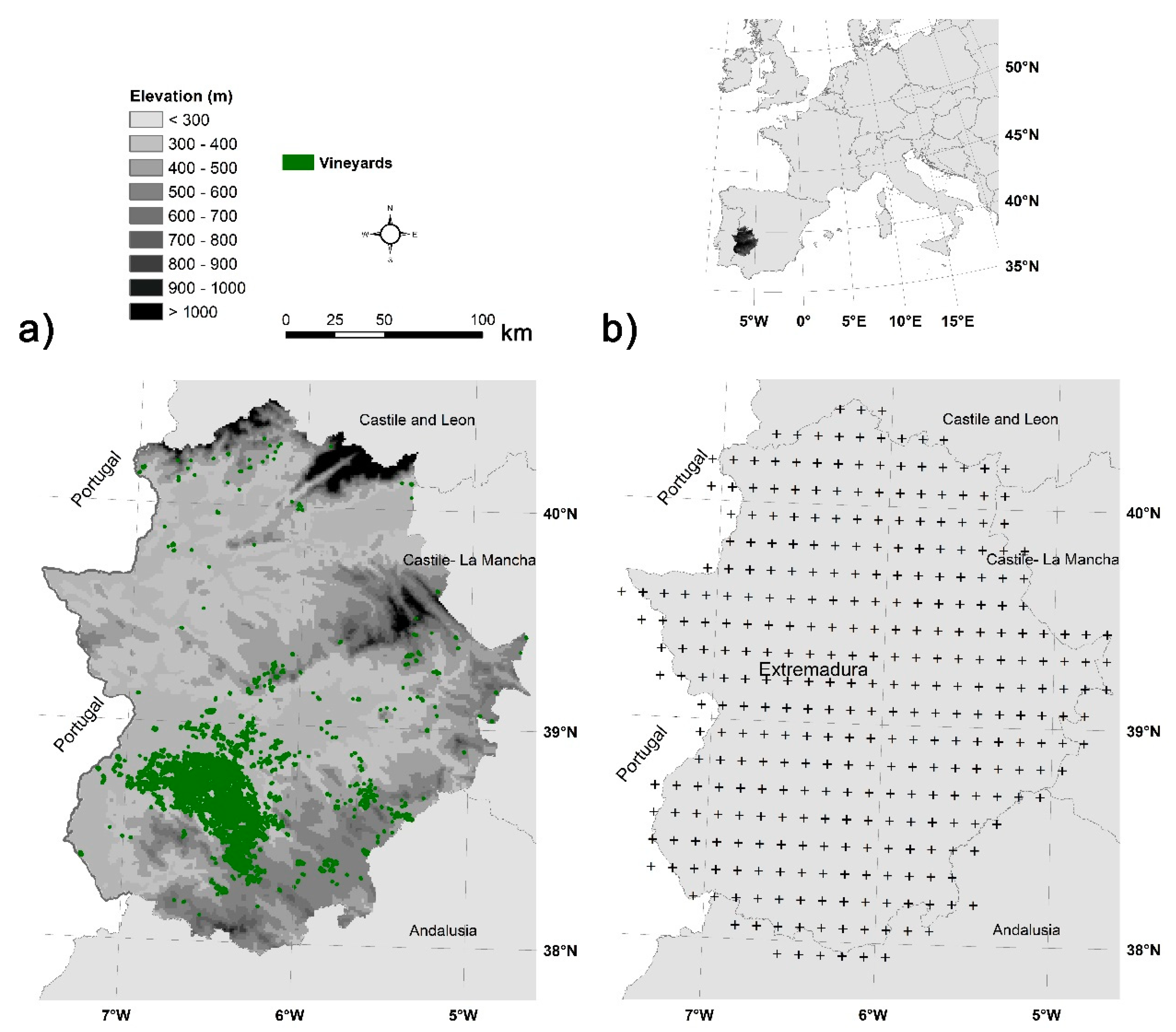
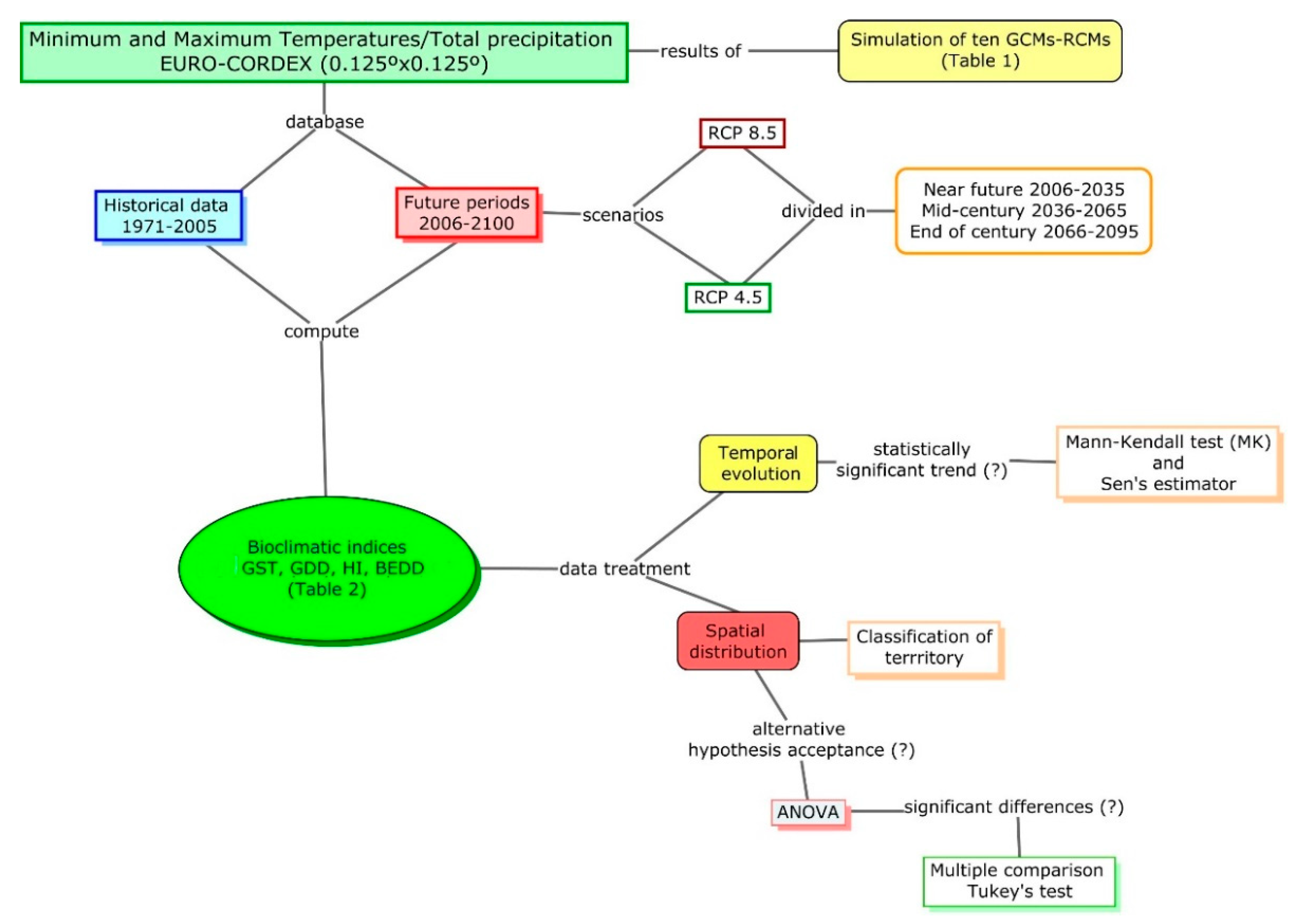
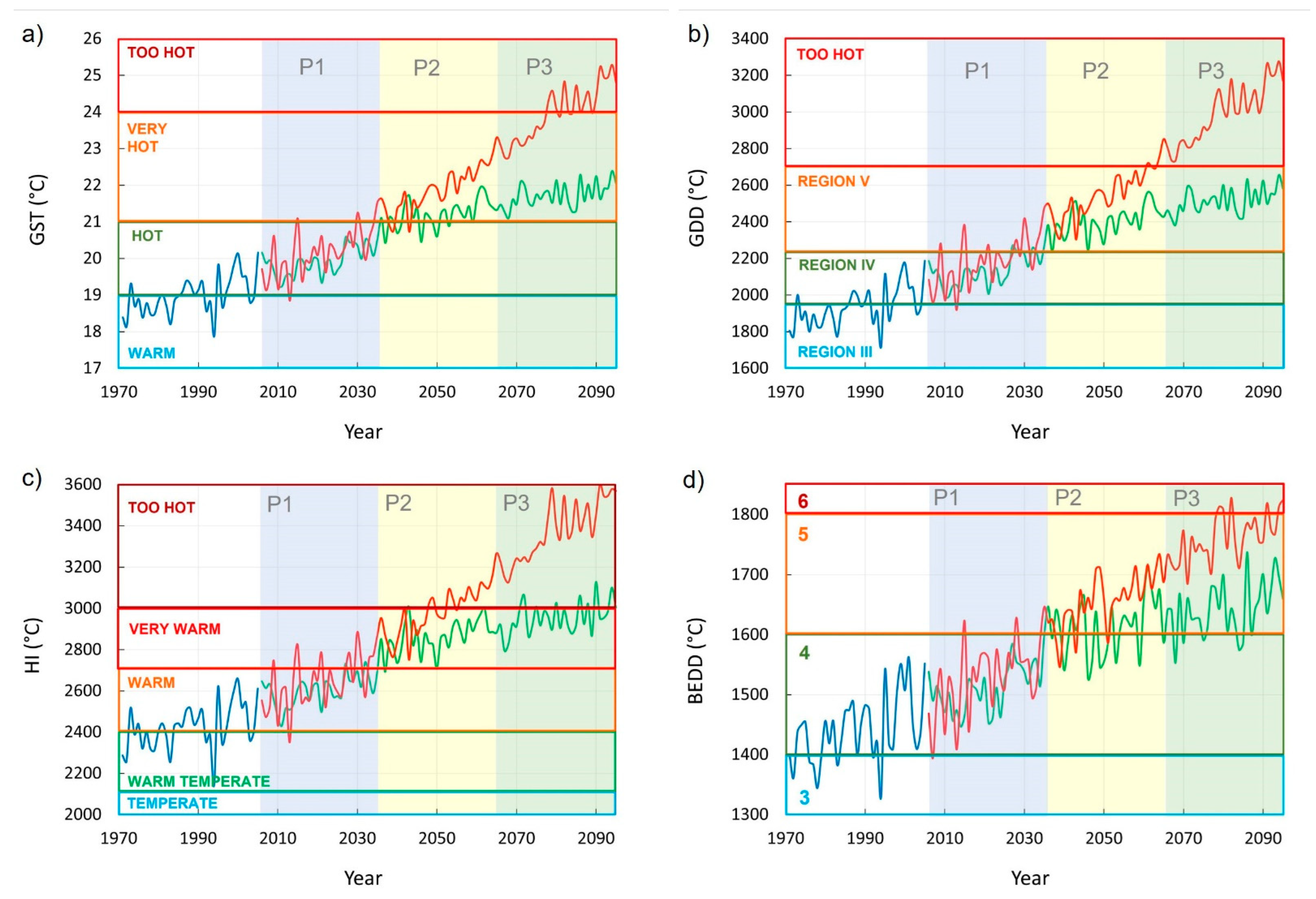

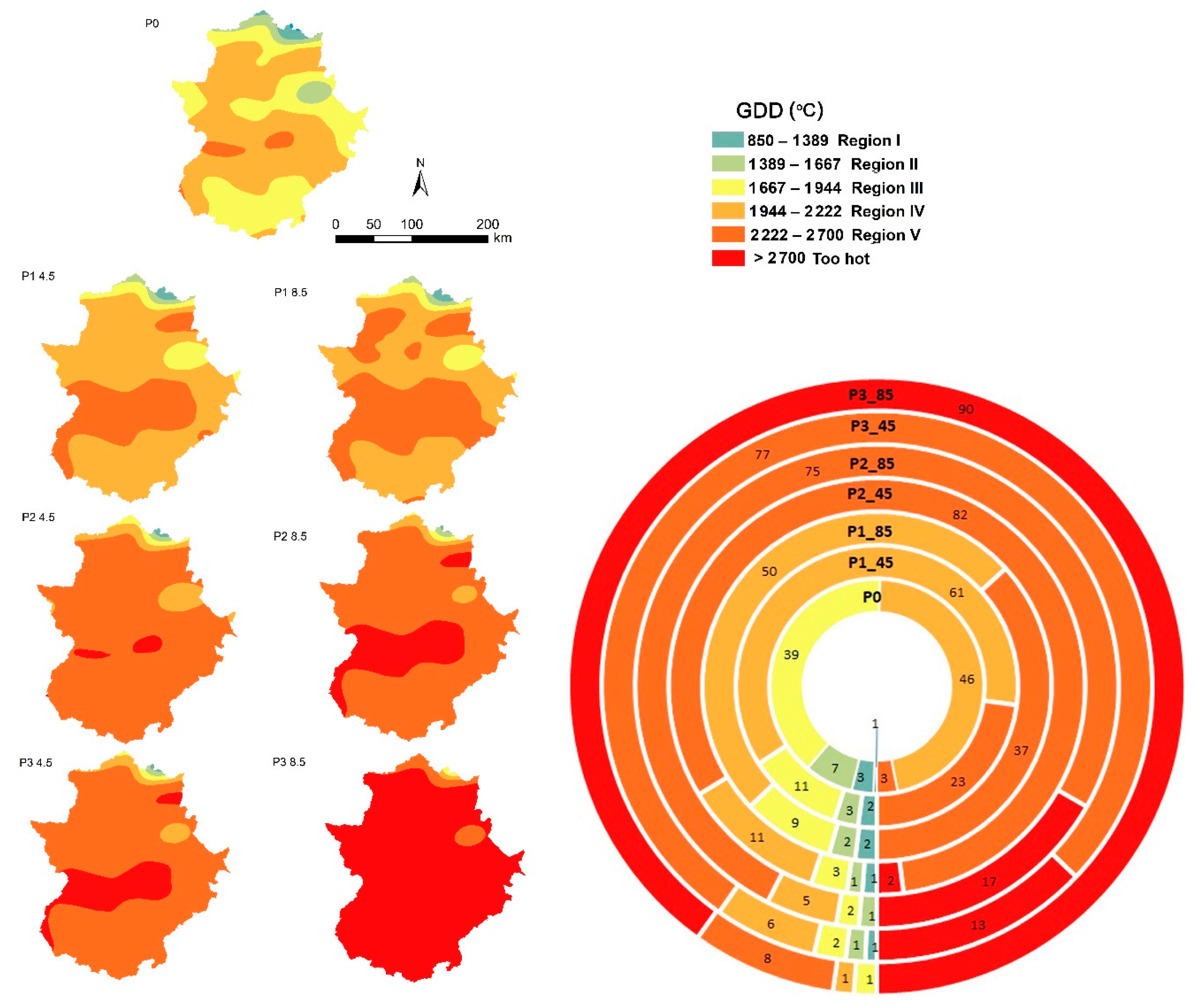
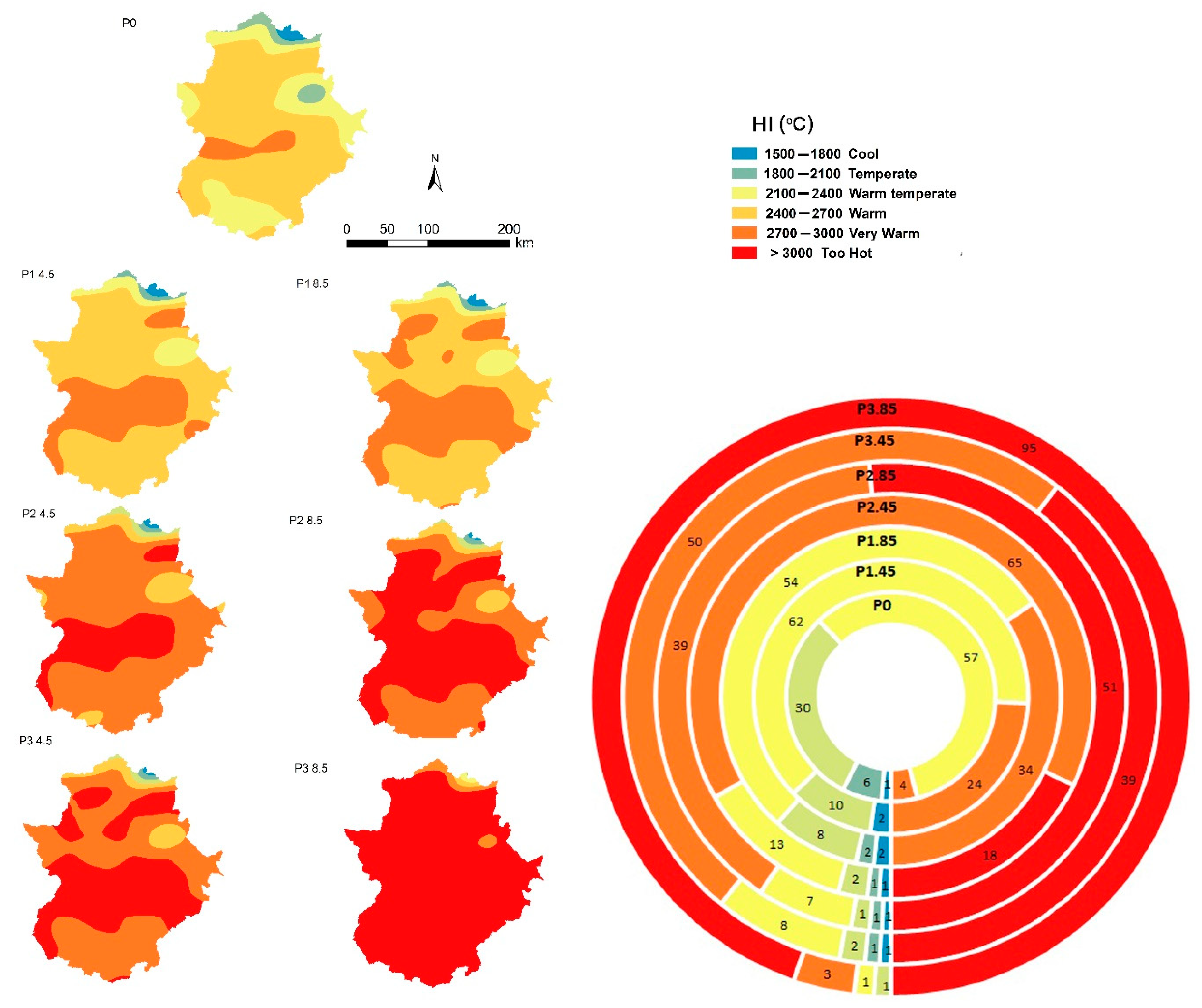

| Global Model | Regional Model | |||
|---|---|---|---|---|
| CCLM4-8-17 | RCA4 | RACMO22E | REMO2009 | |
| CNRM-CM5 | X | X | ||
| EC-EARTH | X | |||
| IPSL-CM5A-MR | X | |||
| MPI-ESM-LR | X | X | X | |
| MOHC-HadGEM2-ES | X | X | X | |
| Index | Equation | Months | Class Limits |
|---|---|---|---|
| GST | 1 April– 31 October |
| |
| GDD or WI | 1 April– 31 October |
| |
| HI | where K is an adjustment for latitude/day length | 1 April– 30 September |
|
| BEDD | where and K is an adjustment for latitude/day length | 1 April– 31 October |
|
| GST | GDD | HI | BEDD | |||
|---|---|---|---|---|---|---|
| Historical Period | P0 (1971–2005) | Mean | 19.0 | 1935.8 | 2426.4 | 1442.8 |
| CV (%) | 9.1 | 18.3 | 14.6 | 12.6 | ||
| RCP 4.5 | P1 (2006–2035) | Mean | 19.9 | 2132.1 | 2604.5 | 1511.6 |
| CV (%) | 9.0 | 17.4 | 14.0 | 11.6 | ||
| P2 (2036–2065) | Mean | 21.2 | 2404.6 | 2863.5 | 1612.7 | |
| CV (%) | 9.1 | 16.9 | 13.7 | 10.1 | ||
| P3(2066–2095) | Mean | 21.7 | 2516.6 | 2954.9 | 1643.3 | |
| CV (%) | 9.2 | 16.9 | 14.0 | 10.1 | ||
| RCP 8.5 | P1 (2006–2035) | Mean | 20.2 | 2184.9 | 2644.8 | 1528.4 |
| CV (%) | 9.4 | 18.1 | 14.3 | 11.4 | ||
| P2 (2036–2065) | Mean | 21.9 | 2555.2 | 2989.7 | 1656.4 | |
| CV (%) | 9.3 | 17.0 | 13.7 | 9.3 | ||
| P3(2066–2095) | Mean | 24.0 | 2998.3 | 3377.8 | 1761.0 | |
| CV (%) | 9.3 | 15.9 | 13.2 | 7.4 | ||
| ZMK | β | RC (%) | ||
|---|---|---|---|---|
| Historical Period | GST | 3.58 *** | 0.03 | 5.88 |
| GDD | 3.66 *** | 6.81 | 12.32 | |
| HI | 2.87 ** | 5.51 | 7.95 | |
| BEDD | 2.84 ** | 2.63 | 6.38 | |
| RCP 4.5 | GST | 10.18 *** | 0.03 | 12.61 |
| GDD | 10.22 *** | 6.21 | 23.77 | |
| HI | 9.60 *** | 5.65 | 18.12 | |
| BEDD | 8.15 *** | 2.19 | 12.38 | |
| RCP 8.5 | GST | 12.19 *** | 0.06 | 26.13 |
| GDD | 12.19 *** | 13.64 | 47.61 | |
| HI | 11.95 *** | 12.20 | 36.56 | |
| BEDD | 11.14 *** | 3.74 | 20.40 | |
Publisher’s Note: MDPI stays neutral with regard to jurisdictional claims in published maps and institutional affiliations. |
© 2022 by the authors. Licensee MDPI, Basel, Switzerland. This article is an open access article distributed under the terms and conditions of the Creative Commons Attribution (CC BY) license (https://creativecommons.org/licenses/by/4.0/).
Share and Cite
Moral, F.J.; Aguirado, C.; Alberdi, V.; García-Martín, A.; Paniagua, L.L.; Rebollo, F.J. Future Scenarios for Viticultural Suitability under Conditions of Global Climate Change in Extremadura, Southwestern Spain. Agriculture 2022, 12, 1865. https://doi.org/10.3390/agriculture12111865
Moral FJ, Aguirado C, Alberdi V, García-Martín A, Paniagua LL, Rebollo FJ. Future Scenarios for Viticultural Suitability under Conditions of Global Climate Change in Extremadura, Southwestern Spain. Agriculture. 2022; 12(11):1865. https://doi.org/10.3390/agriculture12111865
Chicago/Turabian StyleMoral, Francisco J., Cristina Aguirado, Virginia Alberdi, Abelardo García-Martín, Luis L. Paniagua, and Francisco J. Rebollo. 2022. "Future Scenarios for Viticultural Suitability under Conditions of Global Climate Change in Extremadura, Southwestern Spain" Agriculture 12, no. 11: 1865. https://doi.org/10.3390/agriculture12111865









